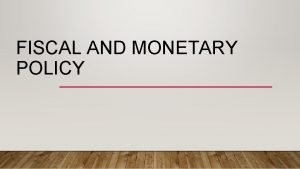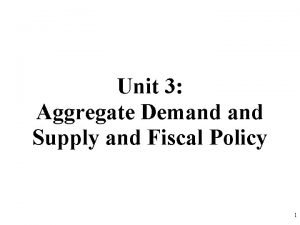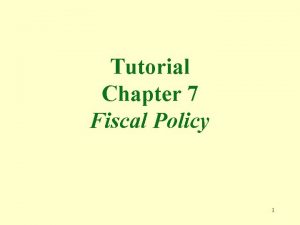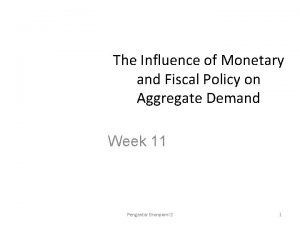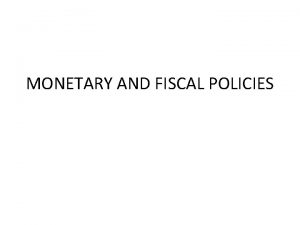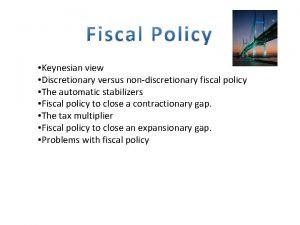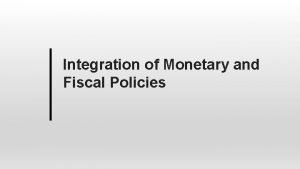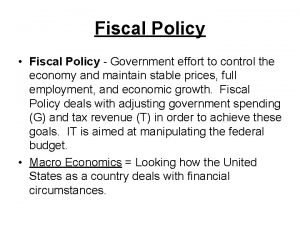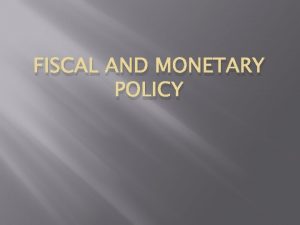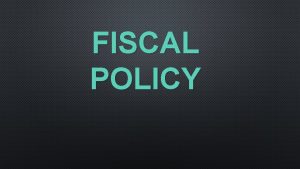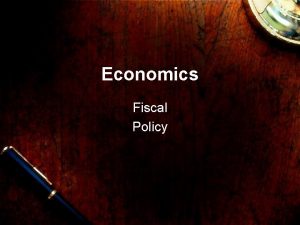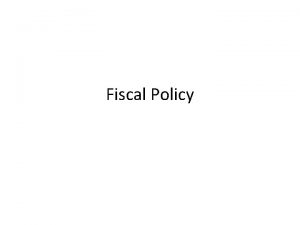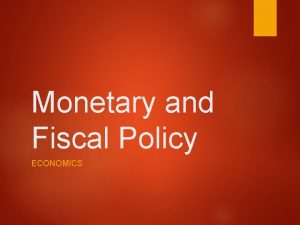Monetary Fiscal Policy Whats the difference Monetary Policy














- Slides: 14

Monetary & Fiscal Policy: What’s the difference?

Monetary Policy… • “Monetary Policy" refers to what the Federal Reserve (“the fed”) does to influence the amount of money and credit in the U. S. economy. In other words, monetary involves controlling the money supply. • What happens to money and credit affects interest rates (the cost of credit) and the performance of the U. S. economy.

Goals & Purpose of Monetary Policy • By implementing effective monetary policy, the Fed can maintain stable prices, thereby supporting conditions for long-term economic growth and maximum employment. Two primary purposes: • To stimulate or constrain total spending • To guard against inflation or deflation • Inflation- a rise in the general level of prices for goods and services in the economy (devaluation of the dollar) • Deflation- a decrease in the general level of prices

Monetary Policy… Federal Reserve System: • Serves as central bank of United States • Has 12 regional banks and a Board of Governors appointed by the President for 14 year terms (so they’re insulated from the political process) • Current Chairman of Federal Reserve: Ben Bernanke • Federal Open Market Committee (FOMC) is the policy-making body of the Federal Reserve System, examines “economic indicators” prior to determining monetary policy.

“Economic Indicators” Economic indicators provide a “snapshot” of the economy’s health. Indicators include: 1) Gross Domestic Product (GDP): The total market value of all final goods and services produced in a country in a given year, equal to total consumer, investment and government spending, plus the value of exports, minus the value of imports. The GDP report is released on the last day of each quarter and reflects the previous quarter. 2) Consumer Price Index (CPI): Measures changes in the price level of consumer goods and services purchased by households. It also includes housing sales, electricity, food, and transportation. The annual percentage change in a CPI is used as a measure of inflation. The CPI is published monthly and is also called cost-of-living index. 3) Unemployment Rate: Currently at 8. 9%

Video Clips • http: //www. youtube. com/watch? v=g. JPs. A_G Vo. W 0 • http: //www. youtube. com/watch? v=jli 4 h. MYs. E c. U

How does the Federal Reserve control the money supply? 1. Open Market Operations: (most important) • Buying and selling of U. S. government securities (bonds) • When the Fed buys bonds it holds the securities and the former owners now have cash to spend → increases money supply • When the Fed sells bonds it takes in cash and individuals hold on to bonds (savings) → decreases money supply

2. Discount Rate • The interest rate the Fed charges member banks for loans • Deceasing this rate leads to member banks lowering rates to customers → increased borrowing and spending 3. Reserve Requirements (not frequently used) • The Fed sets what percentage of total deposits a bank must keep on hand • Lowing the requirement means the more money a bank can lend → increase in money supply

Fiscal Policy: Where does tax revenue come from? • Fiscal Policy: • While monetary policy is the government’s control of the money supply and interests rates to stabilize the economy, fiscal policy is the use of government spending and taxes to influence the economy. • Federal Income Tax: § Largest source of revenue: around 40% § It’s a progressive tax system § Paid by individuals and corporations • Social insurance taxes: § Employee contributions to the Social Security and Medicare systems.

• Borrowing § Deficit spending- requires bonds help by the American public, companies, and foreign entities. • Other taxes § Excise taxes- on liquor, gas, etc… § Estate tax

Where do our tax dollars go? • Entitlement Programs: § Social security & Medicare (~ 41% of spending) • National Defense: § 18% of total federal budget • National debt: § 8% of the total budget goes to pay the interest on our national debt! § Total debt has increased over $500 billion each year since FY 2003, with increases of $1 trillion in FY 2008 and $1. 9 trillion in FY 2009. § National Debt = $11. 4 trillion (and counting)


How can government spending and taxes be used to manage the economy? • Some theories… • Laissez-Faire Economics: § Allowing the capitalist free market to work without intervention is best. § Adam Smith, Scottish economist, argued that the “invisible hand” of supply and demand ensures efficiency § People who ascribe to this theory are referred to as “Classical” economists

• John Maynard Keynes & Keynesian Economics § Lived through the Great Depression: something was wrong, the economy was not recovering as classical theorists predicted. § Developed the radical notion that government spending and taxes could lift a country out of a depression and used to reduce dramatic swings in the business cycle § Example: government spending during a recession could increase demand put people back to work. President Obama and the American Recovery and Reinvestment Act (2009) to help the country through the “Great Recession”.
 Contractionary money policy
Contractionary money policy Fiscal vs monetary policy
Fiscal vs monetary policy Inflation
Inflation Example fiscal policy
Example fiscal policy Government expenditure multiplier formula
Government expenditure multiplier formula Components of fiscal policy
Components of fiscal policy Crowding out effect of fiscal policy
Crowding out effect of fiscal policy What is liquidity ratio in banking
What is liquidity ratio in banking Discretionary and non discretionary fiscal policy
Discretionary and non discretionary fiscal policy Fiscal policy
Fiscal policy Ib economics fiscal policy
Ib economics fiscal policy Fiscal demand side policy
Fiscal demand side policy Fiscal policy definition
Fiscal policy definition Contractionary fiscal policy
Contractionary fiscal policy Instruments of fiscal policy
Instruments of fiscal policy

